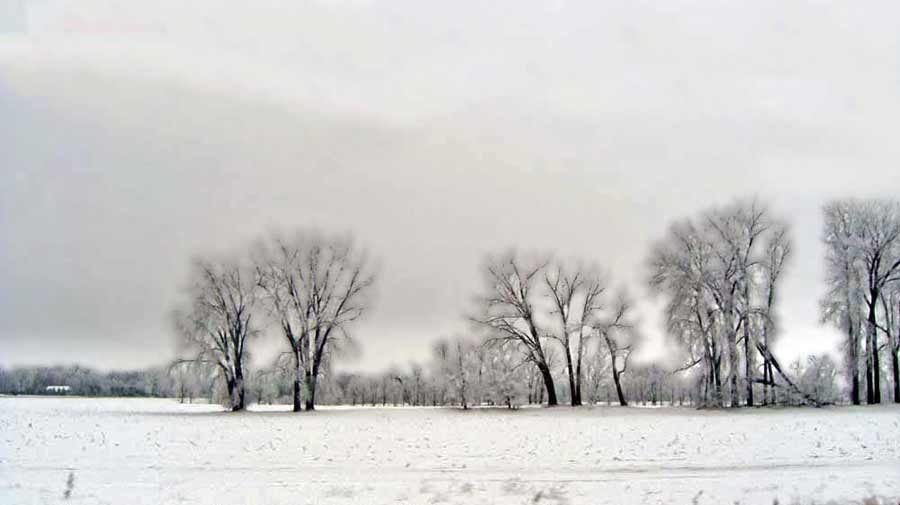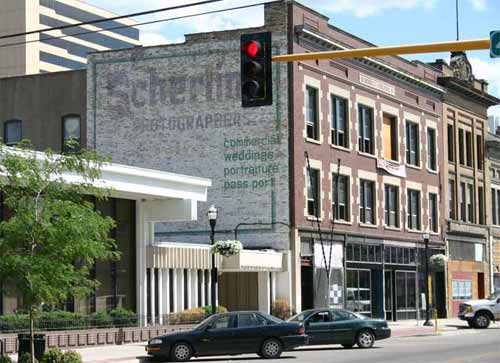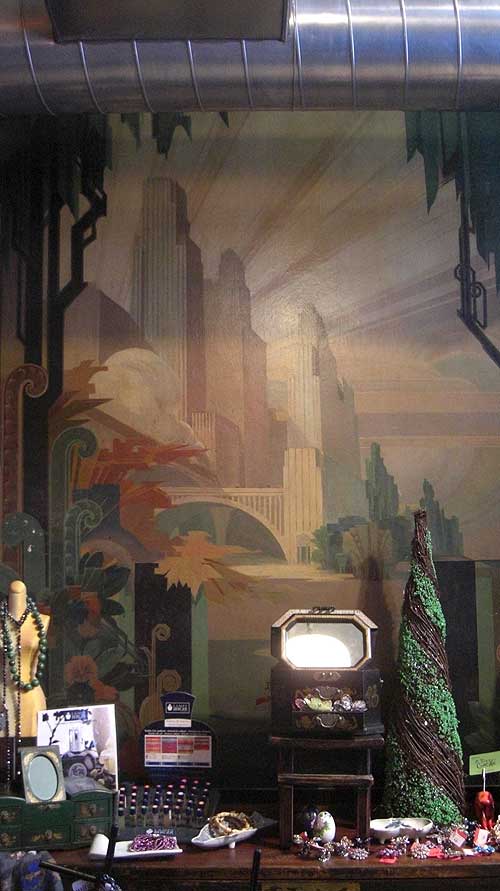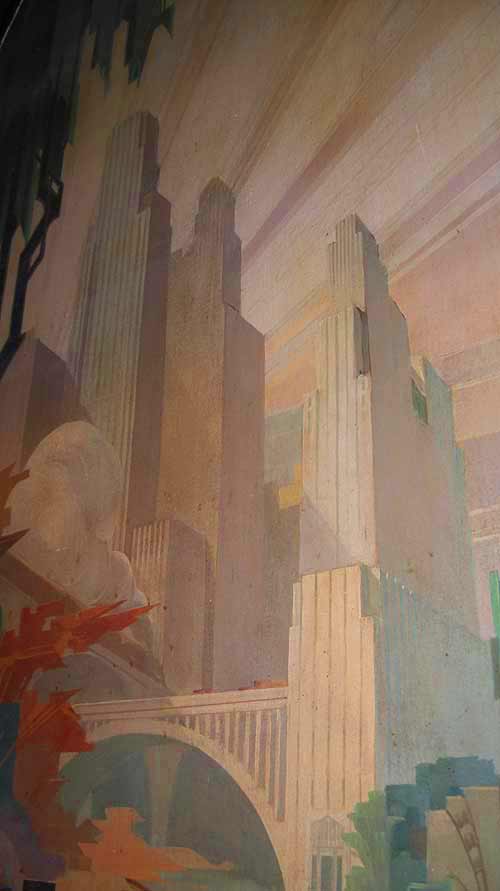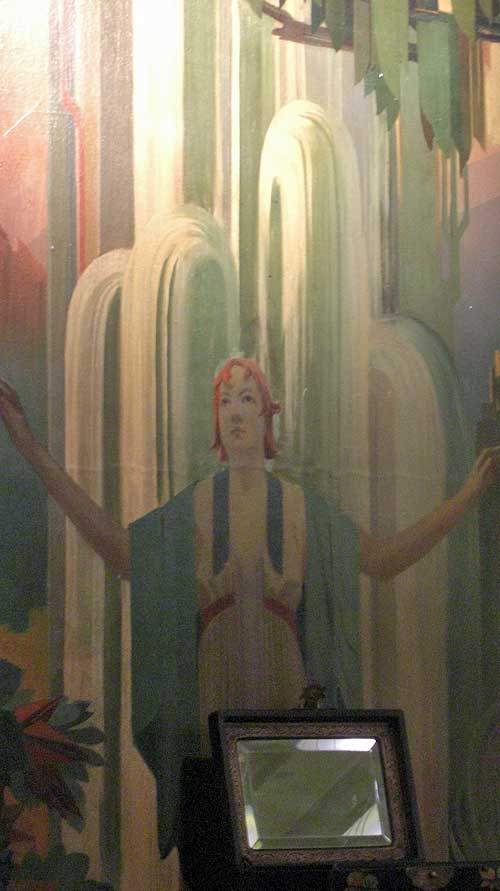
The picture above was taken a week ago, after a frosty morning. It's the fields of North Dakota. Since the Bleat was last posted I’ve been to Fargo and Vegas; we begin in the colder, smaller place. -- 12.26.07 11:07 PM I am in a hotel room in Fargo, across from West Acres. My father’s house is full of his wife’s kids, in for the holiday, and I don’t want to bother my sister by sleeping on the sofa. I would be Uncle Lump around whom tiptoeing would have to occur in the morning, and I don’t want that. Besides, I’m a member of the Holiday Inn Preferred Premier Express Club Whatever, and that gets me silly low rates if the hotel is otherwise empty. And it’s otherwise empty. The day after Christmas, everyone’s gone. That’s fine; I am often happiest when I have a hotel room to myself. I suppose that speaks poorly of me, but it is a rare pleasure to put up your feet, light a cigar indoors, and read a book without interruption. I’ve been reading an account of a 1963 St. Paul murder. It’s quite good, but I remembered that I hadn’t written anything today. So here we are. Writing. The drive up was perfect. I took Highway Ten, the Old Road. Smooth dry pavement and a hit parade of good old time radio on the XM. They were still playing Christmas shows, and for some odd reason I can't explain it seemed right; usually Christmas is over and done on the 26th, and you're almost ready to put out the tree. But the radio kept it going, One hour-long episode was a recreation of a movie I’d never heard of before, a Fred MacMurray-Barbara Stanwyck film called "Remember the Night." Before they did "Double Indemnity" they were a charming mismatched pair who found love against all odds! In a Hollywood movie? you ask. Yes! Imagine the odds. I was so caught up in the story that I did drive-through at lunchtime, lest I miss the show. A cup of coffee, a hot sandwich, a radio play from 1941 - if you're going to be on the road the day after Christmas, that'll do. I pulled into Fargo around 3:30, drove downtown – I always drive through downtown first, no matter where I’m bound – and noted that the Fargoan Hotel had completed its conversion to condos. This reminded me about the mural I’d glimpsed long ago and never forgotten. How I ever saw it, I don't know; we had no reason to enter the Fargoan. Back then it was a hotel for old men and transients who spend their day slumped in the chrome-and-black chairs in the lobby, smoking or dozing in the afternoon sun, idling away the day as an endless number would follow. All I remembered was a brief look at a strange shining city. Whenever I walked past on recent trips to see if it was there, the shades were down.
This is the old Fargoan Hotel in the middle of its makeover into condos. I took the picture last summer, I think. As I drove by today I saw the old marquee was back up, so I parked and had a look. The lobby has been converted into a boutique. The mural was the first thing I saw when I entered.
Wow.
There's another one in the back. The High Priestess of the Moderne Future, standing in front of the Emerald City Cathedral:
All these marvelous paintings in an old hotel lobby in an undistinguished old building in a small city in the middle of the Plains. It makes one wonder what else remains to be discovered, and what losses we'll never know. I got back in the car. I went to West Acres and got a haircut from a woman from South Korea. She spoke English, but not an English I necessarily recognized. Most of what she said I did not get, but I said I would like to visit Seoul. “You eat kimchi?” she said. I said yes, kimchi was fine with me. Could she get kimchi in Fargo? She said she had to make her own. I said you could buy it in Minneapolis. She seemed delighted. I walked out feeling like the most cosmopolitan, worldly fellow she’s cut all day. At the Gap I bought some clothes because I had noticed my good pants had taken on a shine. I would need the good pants tomorrow. Then I tried to find my father’s house. He moved, you know. Moved from our childhood home to a dee-luxe duplex in the burbs of Fargo. I googled his address on my iPhone, ended up on an unpaved road. Unpaved! Unlit! Somehow this was reassuring; even Fargo still has its outlands. When I turned around and headed back to the paved part of town I suddenly got my bearings, and found his house. We chatted for a while and had a cup of coffee and then we went to the visitation. This was the reason I'd come home the day after Christmas. I met him before, I’m sure; he was running around at a family event, or perhaps around the station when I stopped by. He worked for my dad now and then. He was my cousin’s son. My cousin is my age, more or less, but started his family much earlier; he built his house on the family farm, as his father had done, as his grandfather had done. I roll over it on Google Earth from time to time, and see the woods where we played, the barn, the yard, the terrain of the standard Sunday visit. Always Christmas on the farm, Christmas with the cousins, Christmas with Uncle Myron and Auntie Joyce, Christmas with Grandma and Grandpa. In those days before the interstate we took the two-lane home. Now I-29 runs up to Harwood. Around mile marker 71 my cousin’s son Eric had an accident heading home on the night of December 22, and died. I hadn’t seen my cousin since last year, since my dad’s birthday. How are you, he said, and gave me a great hug. It’s the last question you expect to be asked at such a time, and I cannot imagine a finer measure of the man. He pulled my dad over to the display to show him one of the pictures of Eric as a baby, wearing a LILEKS OIL cap. The table had his racing helmet, still spattered with mud; pictures of him in his car, photos of him as a young man dressed in a Star Trek uniform, school portraits, holiday candids. It all set a stone on your heart. The speeches at the visitation brought the young man to life for those of us who hadn't known him, and thanks to his friends I got a sense of his character - decent, generous, endearingly goofy at times. A big kid. My cousin got up to speak and noted the size of the crowd with a rueful grin: and he thought he didn't have enough friends. He has to be looking at us now and just giggling. My cousin spoke of his love for his son and his belief in the reasons behind the senseless events of life and he told us all not to worry about small things, and hug our kids. He held it together. I don't know how one holds it together at such a time, but he probably would have said the same thing before. It wasn't a somber event. In fact the room rocked with laughter a dozen times as people told their favorite stories. Like I said, I didn't know him, but from what I learned I suspect he would have enjoyed the response. Who knows what a room full of silent people are thinking? A room bright with laughter: you know. |
||

12.27.07 This was the site of the funeral and burial. The Maple-Sheyenne Church. A tiny old building - now in its third century, I believe - along a two-laner in the fields southwest of Harwood. This was my grandparent's church as well - in fact my ancestors who immigrated to the United States were one of the founders of the church, and their names are in the stained-glass window in the ten-pew sanctuary. Like many churches, it was remodeled in the sixties - the same light-wood modernism of my home church in Fargo, with conical brass lamps identical to those found in the basement of the '63 Rambler in which I grew up. The ceiling is pressed tin with ornate patterns, probably original, cut to fit, probably ordered from a place out East in the late 1800s. The inevitable felt banners with stylized religious imagery could be 1969 or 1989 or last year. At the end of the service the pallbearers stood – all members of his racing team, wearing the team jacket. The coffin went out. The family members followed, I think, the horrible finality of the moment on everyone’s face. The funeral ceremonies are a means of keeping the deceased alive for a while, a transition from the right side of the ground to the hard side, but when the box rolls down the aisle it’s well and truly done. We lined up for buns and coffee in the Fellowship Hall. My dad pointed out some pictures on the wall: men who’d been baptized in the church and served in the military. There was my uncle. There was Dad’s friend, KIA USS ARIZONA 12/7/41. After a while I said goodbyes and stepped outside. You know it’s a funeral in a small rural church when you see this. People parked on the shoulder for almost a good mile.
|
||

The way back home was south on I-29 to Highway Ten, the Old Road, and thence to Jasperwood. But I drove north on I-29. The summer they laid down this road my cousin and I snuck onto the freeway before it had opened, and drove our 65cc Hondas up and down the private highway. I drove past mile marker 71. There wasn’t any sign anything had happened here. You wouldn't know unless you knew, and if you knew, you wouldn't forget. I drove around Harwood for a while, working off a few scant memories of hot summers in the sixties, of walking across the bridge into town. It was only a bank and a bar and a handful of houses, a giant silent elevator, the bright silver lines of the train tracks. Now it’s all of that and more: an elementary school, a firehouse, a c-store, more houses. Harwood thrives, in part because of people like my cousin, who stayed. Stayed and built. Stayed and built a family and farmed the land his forefathers farmed. And so the town will outlive him and the church will outlive him and everyone will eventually gather at the grave again – some beside, some within. An hour later I was on the road heading home. Frost had touched everything. It’s not the sort of beauty you’d seek, but it’s beauty you can’t deny. |
||
